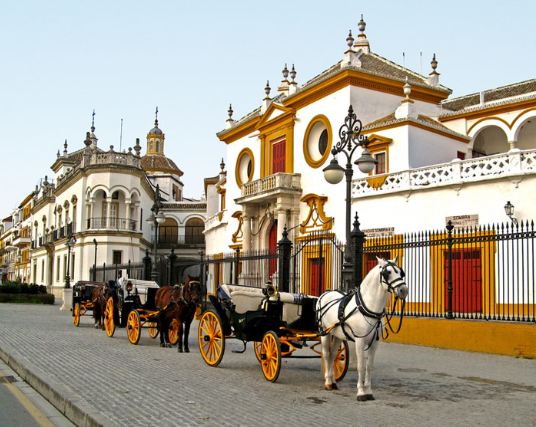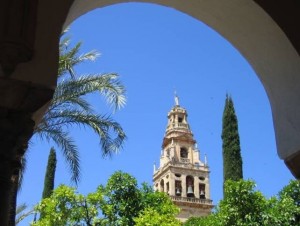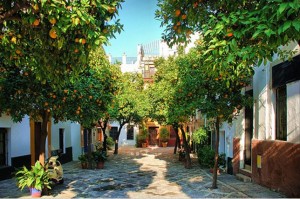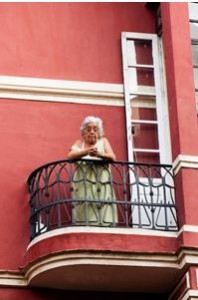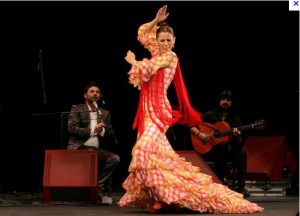Seville
A highlight not to be missed:
The traditional Seville
Seville is the capital of the Spanish autonomous region of Andalusia and it is the main city of southern Spain in the field of culture, politics, economics and art. This city, situated on the river Guadalquivir, is the lively centre of the region and has about 750,000 inhabitants. Seville is a city where you will not get bored because this very traditional town full of life has a lot to offer. Who comes to Seville searching for art and culture has certainly come to the right place. But there are also many cosy restaurants and cafes, and the nightlife is simply sparkling. The town is charming and its people hospitable. In Spain, Seville is known for its unofficial and very different dialect that is spoken.
TIP FROM A LOCAL:
Highlights of Seville
The Cathedral and the Giralda Tower
Seville Cathedral is the largest Gothic building in the world and the third largest church in Europe. The “Catedral de Santa Maria de la Sede” was built in the 15th century on the place of a Moorish mosque from the 12th century. Of that mosque only the Patio de los Naranjos and the minaret are still remaining. The interior is richly decorated: stained glass windows from the 15th century, wrought iron railings, beautiful choir stalls and a beautiful baroque reconstruction of the organ. The highlight is the Capilla Mayor (main chapel) with an altar piece decorated with gilded wood.
The Giralda tower is 97 meters high but there are no steps. You can walk through a corridor to the sloping top. Once, the tower was a minaret, now is the bell tower of the Cathedral.
Alcázar (Royal Palace) of Seville
he Royal Palace is still used by the Spanish king and queen when they are visiting Seville. That does not happen very often so it is possible to walk through this palace with an unmistakable Moorish appearance, which is not surprising since the architects were Moors. In the middle, there is an elongated pond surrounded by sunken gardens. Around the patio there is a gallery and the top floor has a Renaissance style, which was then added later, under the reign of Charles V.
The gardens are very beautiful, especially during Spring, when the orange gardens blossom. The palace with its many peacocks and palm trees is also a popular wedding venue.
Torre del Oro
Where the name of Torre del Oro (Gold Tower) comes from is to this day unclear. Was it the golden tiles that the tower was once decorated with or the treasures that Spain took from America? Anyway, it’s a beautiful tower and a nice vantage point.
Plaza de Toros (arena)
The Plaza de Toros is one of the oldest and certainly one of the finest arenas for bullfighting in Spain. To see a bullfight, you must be in Seville between April and September.
Museo Provincial de Bellas Artes Sevilla
The Museum of Fine Arts is housed in a former monastery and is one of the most important art museums in Spain. You will mainly find religious art, from churches and monasteries, with works by Zurbarán, Murillo and Valdés Leal but Flemish and Italian art is represented too.
Barrio de Santa Cruz
The former Jewish quarter is one of the major attractions of Seville. Walk through picturesque streets and alleys and enjoy the tapas in one of the many restaurants. The Santa Cruz district is the former Jewish quarter of Seville. King Ferdinand III forced the Jews to settle in this area and In the 14th century, Christians took over the helm and turned Santa Cruz into a working-class neighbourhood. Now it is a tourist attraction with narrow streets and picturesque alleys.
Plaza de España
The Plaza de España is a remnant of the Spanish-American Exhibition in 1929. Architecture lovers will be impressed by the Spanish Pavilion and the square that is full of symbolism. It was designed by architect Aníbal González, who was in charge of the exhibition project. It was the most expensive pavilion of the exhibition and the square is also huge: 50,000 m2.
The Triana district and the Triana Bridge
This district is on the other side of the river with many terraces along it. There is also a bridge called Puente Isabel II, which is beautifully lit at night. From here, you have a beautiful view of the historic Seville. Former sailor quarter was from the 16th to the mid-17th century, an important location for numerous craftsmen. The trade with the colonies arose numerous workshops where pottery and tiles were manufactured. You can still buy beautiful tiles today. These are ceramic tiles which usually blue-painted pictures or letters painted on it.
The classic Macarena neighbourhood
This district is much more authentic than Santa Cruz.
Metropol Parasol
Metropol Parasol, the world’s largest wooden structure, was completed in April 2011. It is surrounded by richly decorated patios, peacocks and palm trees, picturesque squares, churches (many churches) and of course the cathedral, where Christopher Columbus is buried.
The best time to visit Metropol Parasol is at around eight o’clock in the evening. The roof terrace is open from 10-14.00 and 18.-23.00.
Flamenco music and dance
Andalusia is the birthplace of flamenco and you cannot avoid it. The name stands for the combination of Flamenco dance and music that evokes a certain atmosphere. The aim is for both the dancers and the audience to bring that called “Duende” in a certain atmosphere.
You can share the experience in one of the many ‘tablaos Flamenco’ in Seville. A nice bar where you can get free watching and listening is ‘La Carbonería’ on calle Levies. Here, there is a nice mix of tourists and locals present.
Weather in Seville
Seville is known for its extremely hot climate. The average annual temperature is 18.6 degrees Celsius and this makes Seville one of the warmest cities in Europe. Winters are very mild and summers are hot, dry and long. From March to November, the temperature can reach 30 degrees and in July, the average maximum temperature is normally 35.3 degrees and the 40 degrees limit is exceeded with much regularity.
But that’s not reason to miss it. You can do as the locals: buy a fan, take a short afternoon siesta short and just do it a bit easier. You know what they say: “Quien no ha visto Sevilla, no ha visto maravilla”, which roughly translated means: “Who has not seen Seville, has missed a miracle.”
